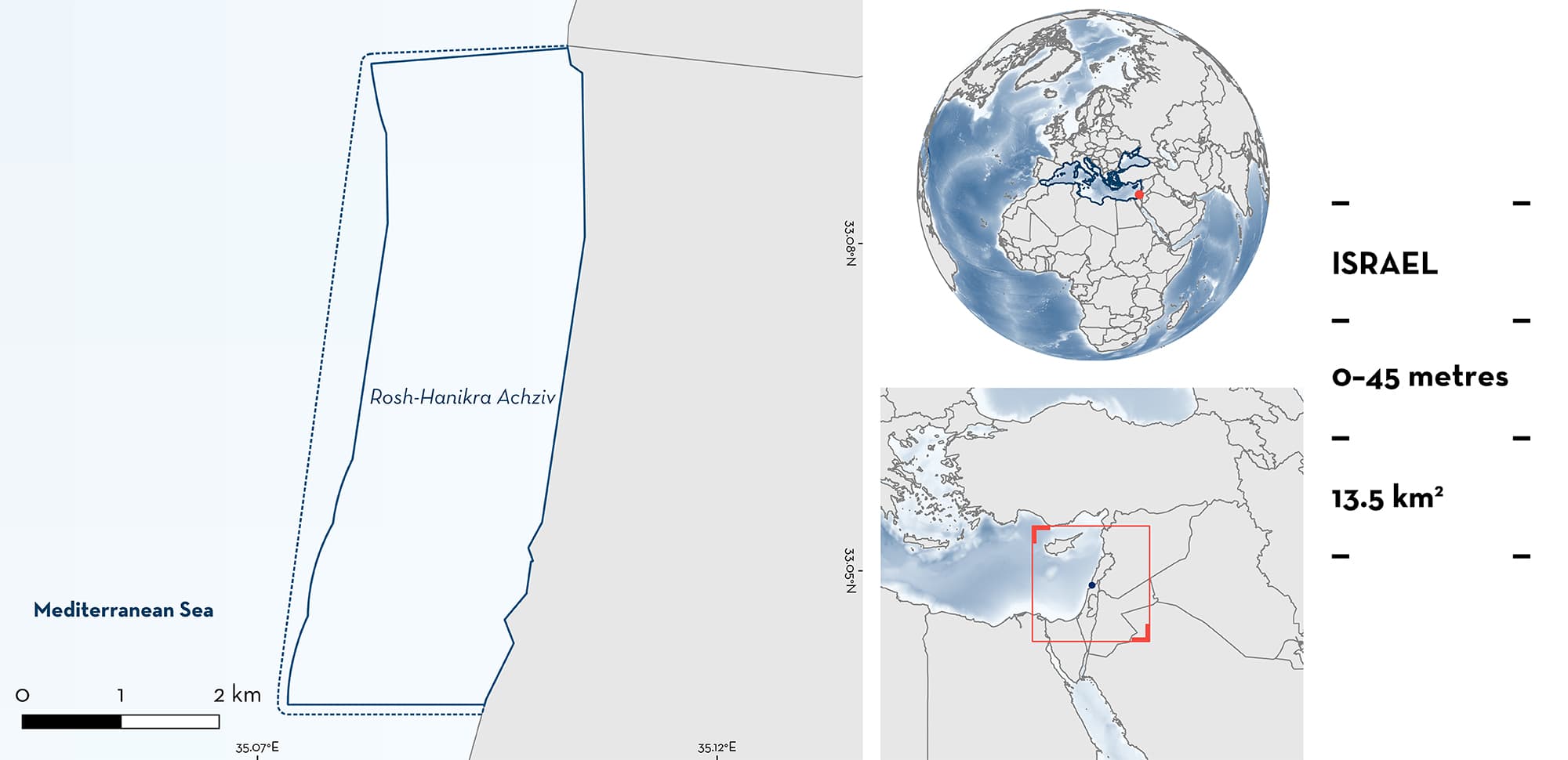ISRA FACTSHEETS
ISRA FACTSHEETS
MEDITERRANEAN AND BLACK SEAS REGION
Rosh-Hanikra Achziv
Summary
Rosh-Hanikra Achziv is a coastal area in northern Israel that overlaps with the larger Rosh-Hanikra Achziv Marine Protected Area. This area is characterised by a variety of unique habitats, including abrasion tables bordering the shoreline and sandy substrate habitats, and hosts rich and diverse communities. Within this area there are: threatened species (e.g., Spiny Butterfly Ray Gymnura altavela); reproductive areas (Round Fantail Stingray Taeniurops grabatus); and undefined aggregations (e.g., Duckbill Eagle Ray Aetomylaeus bovinus).
Download factsheet
Rosh-Hanikra Achziv
DESCRIPTION OF HABITAT
Rosh-Hanikra Achziv is located in northern Israel. It extends from the shoreline to 2 km to the west, where it reaches a depth of 45 m. The area hosts rich and diverse fish and invertebrate communities and consists of varied habitats, including abrasion tables bordering the shoreline and sandy substrate habitats. Submerged eolianite Kurkar ridges (a unique endemic structure of lithification of ancient dunes) form steep, complex rocky formations and small islands 1 km offshore.
The surrounding Rosh-Hanikra Achziv Marine Protected Area (MPA) is the largest and most consistently enforced MPA in Israel. The area also overlaps with the East Levantine Canyons Area Ecologically or Biologically Significant Marine Area.
This Important Shark and Ray Area is benthopelagic and is delineated from inshore and surface waters (0 m) to 45 m based on the observations of the Qualifying Species and on the bathymetry of the area.
CRITERION A
VULNERABILITY
Three Qualifying Species considered threatened with extinction according to the IUCN Red List of Threatened SpeciesTM regularly occur in the area. These are the Critically Endangered Duckbill Eagle Ray (Jabado et al. 2021a) and Lusitanian Cownose Ray (Jabado et al. 2021b), and the Endangered Spiny Butterfly Ray (Dulvy et al. 2021).
CRITERION C
SUB-CRITERION C1 – REPRODUCTIVE AREAS
Rosh-Hanikra Achziv is an important reproductive area for one ray species.
Citizen science observations through the MECO project have reported Round Fantail Stingrays predominantly from the northern coastal part of the area. Round Fantail Stingrays are the most frequently seen ray species here and have been observed 819 times in the area (over 2,000 individuals) since 2005 (Barash et al. 2018; the MECO project unpubl. data 2023). Adults are present year-round, with larger aggregations of up to 30 individuals recorded in the boreal spring and autumn (May–June and October–November), when mating behaviour, mating scars, and pregnant females have often been reported. Individuals that were visually estimated to be <30 cm disc width (DW) have been seen in shallow waters (26 records). Size-at-birth for the species is unknown, but, for the closely-related Blotched Fantail Ray Taeniurops meyeni, it is 30–35 cm DW (Last & Stevens 2009), supporting that those <30 cm DW were neonates.
CRITERION C
SUB-CRITERION C5 – UNDEFINED AGGREGATIONS
Rosh-Hanikra Achziv is an important area for undefined aggregations of three ray species.
Spiny Butterfly Rays of both sexes have frequently been seen, with 160 observations of over 1,200 individuals in total made in Rosh-Hanikra Achziv since 2011 (Barash et al. 2018; the MECO project unpubl. data 2023). Adults are present year-round, with larger aggregations of up to 15 individuals recorded in spring and autumn (May–June and October–November). The reasons for these aggregations are not yet understood, although the area may be important for reproduction. Females with distended abdomens were documented seven times from April–June between 2015–2022, and twice in November–December (2019–2020), suggesting that they may be gestating in the area, but mating or neonates have not been reported and further investigations are needed to clarify the driver of the aggregations.
Duckbill Eagle Rays have been regularly seen each year since 2012, predominantly between July and November (75 observations), and frequently in large groups (8 observations of 3–15 individuals) (Barash et al. 2018; the MECO project unpubl. data 2023). The reason for the regular presence of this species is not yet understood.
Lusitanian Cownose Rays have been seen annually since 2013, predominantly between July and December (96 observations), with larger aggregations (11 observations of 3–10 individuals) mostly recorded in November (Barash et al. 2018; the MECO project unpubl. data 2023). The largest aggregation of 13 individuals was recorded in shallow waters in May. The reason for the regular presence of this species is currently unknown.
Download factsheet
SUBMIT A REQUEST
ISRA SPATIAL LAYER REQUEST
To make a request to download the ISRA Layer in either a GIS compatible Shapefile (.shp) or Google Earth compatible Keyhole Markup Language Zipped file (.kmz) please complete the following form. We will review your request and send the download details to you. We will endeavor to send you the requested files as soon as we can. However, please note that this is not an automated process, and before requests are responded to, they undergo internal review and authorization. As such, requests normally take 5–10 working days to process.
Should you have questions about the data or process, please do not hesitate to contact us.


